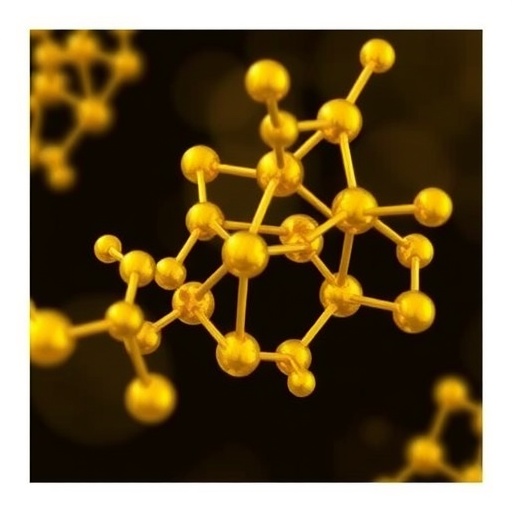In a groundbreaking study, researchers have uncovered a novel approach to enhancing antibacterial strategies against the formidable pathogen, Streptococcus pneumoniae (S. pneumoniae). This bacterium is notorious for its role in severe respiratory infections, and its increasing resistance to standard antibiotics has raised alarm bells among health professionals. The traditional routes of antibiotic treatments have been met with significant challenges, as S. pneumoniae has displayed an ability to evade conventional therapies through various mechanisms. The advent of leverage technological advances offers a glimpse of hope in the ongoing battle against this resilient pathogen.
The centerpiece of this research is a formulation of gold nanoparticles (AuNPs) that have been meticulously functionalized with vancomycin, a well-known antibiotic effective against Gram-positive bacteria. The innovative aspect of this formulation lies in its dual-action mechanism. Previous studies predominantly focused on the antibacterial viability in isolation, neglecting the crucial stage of bacterial adherence and invasion, which are pivotal for establishing infections. The new findings indicate that vancomycin-conjugated AuNPs not only enhance the antibacterial efficacy but also present a formidable barrier against S. pneumoniae colonization.
The characterization of the nano-formulation utilized advanced techniques including UV-Vis spectroscopy and transmission electron microscopy (TEM). These methods confirmed the successful conjugation of vancomycin to the AuNPs while revealing a consistently uniform spherical size of approximately 23 ± 1 nm. This nanoscale dimension is instrumental, as it facilitates penetration and interactions with bacterial cells, providing a competitive edge over conventional antibiotic formulations. The study’s meticulous attention to characterizing the nanoparticle’s properties highlights a crucial step in ensuring that these formulations deliver on their promises.
Notably, minimum inhibitory concentration (MIC) assays yielded compelling results. The research demonstrated a substantial reduction in the concentrations needed for both AuNPs and vancomycin when used in tandem, significantly decreasing from 512 to 32 µg ml-1 for AuNPs and from 0.5 to 0.125 µg ml-1 for vancomycin. This reduction not only underscores the potential for lower dosages but also opens the door for mitigating the side effects commonly associated with higher antibiotic concentrations. The synergistic effects observed in these MIC assays provide a promising avenue for developing more effective treatment regimens against antibiotic-resistant strains of S. pneumoniae.
Diving deeper into the operational mechanics, the study elucidates how vancomycin compromises the integrity of the bacterial cell wall. This weakening is a crucial turning point as it allows for enhanced penetration of AuNPs into cancer cells and bacteria alike. The subsequent disruption of the bacterial membrane, compounded by oxidative stress, sets off a cascade that ultimately leads to bacterial death. This mechanism starkly contrasts with traditional antibiotic action, suggesting a transformative strategy that combines the strengths of nanotechnology and antibiotic efficacy.
Moreover, the study breaks new ground by showcasing how these AuNPs can inhibit the adherence and invasion of S. pneumoniae to human alveolar epithelial cells, designated as A549 in laboratory settings. In the context of respiratory infections, the ability of S. pneumoniae to adhere to epithelial cells is a fundamental step in the establishment of infection. By obstructing this adherence, the nano-antibiotic could fundamentally alter the course of infection dynamics, shifting the landscape of treatment possibilities.
Safety considerations are paramount in any medical application, and this study addressed potential toxicity thoroughly. The researchers conducted extensive toxicity assays, confirming that the vancomycin-functionalized AuNP formulation was non-toxic to A549 cells. This finding lays the groundwork for future clinical applications, paving the way for human trials that could validate the efficacy and safety of the nano-formulation in real-world settings.
Furthermore, the implications of this research extend beyond its immediate findings. With antibiotic resistance emerging as a significant global health threat, innovative approaches like these could theoretically lead to the creation of bespoke antibiotic therapies tailored to tackle resistant strains of bacteria. The development of nanotechnology-infused drug delivery systems might transform how infections are treated, potentially mitigating the growing statistics of morbidity and mortality associated with resistant bacterial infections.
The integration of nanotechnology into pharmacology is an exciting frontier, and this study exemplifies the possibilities at the intersection of these disciplines. By marrying the established antibiotic capabilities of vancomycin with the advanced properties of gold nanoparticles, researchers have ventured into a promising avenue that may redefine how we combat bacterial infections.
Moreover, this exciting field of research holds transformative potential not just in treating S. pneumoniae infections but also in combating a variety of other pathogens that have proven resistant to conventional antibiotics. The lessons learned from this study might inspire similar formulations targeting other infectious diseases, heralding a new age of treatment modalities.
As this research continues to gain traction, it reinforces the critical need for innovative strategies to combat bacterial infections in an era where standard antibiotics are becoming increasingly ineffective. The outcomes of this study advocate for further exploration and funding into research targeting resistant pathogens, as the global health landscape depends on finding alternatives to conventional antibiotics.
In conclusion, the study presents a promising advancement in the fight against S. pneumoniae, illustrating the potential of gold nanoparticles functionalized with vancomycin. By enhancing antibacterial activity and inhibiting tissue invasion, this novel approach stands poised to make significant contributions to clinical practices in addressing bacterial resistance, providing hope in an otherwise dire situation.
Subject of Research: Vancomycin-conjugated gold nanoparticles for enhancing antibacterial efficacy against Streptococcus pneumoniae
Article Title: Gold nanoparticles functionalised with vancomycin enhance antibacterial activity and inhibit Streptococcus pneumoniae adherence and invasion in alveolar cells
Article References:
Ortiz-Benitez, E.A., Huerta-Flores, D.J., Velázquez-Guadarrama, N. et al. Gold nanoparticles functionalised with vancomycin enhance antibacterial activity and inhibit Streptococcus pneumoniae adherence and invasion in alveolar cells.
J Antibiot 78, 674–685 (2025). https://doi.org/10.1038/s41429-025-00856-1
Image Credits: AI Generated
DOI:
Keywords: Gold nanoparticles, vancomycin, Streptococcus pneumoniae, antibacterial, antibiotic resistance, nanoscale medicine, infection prevention.




